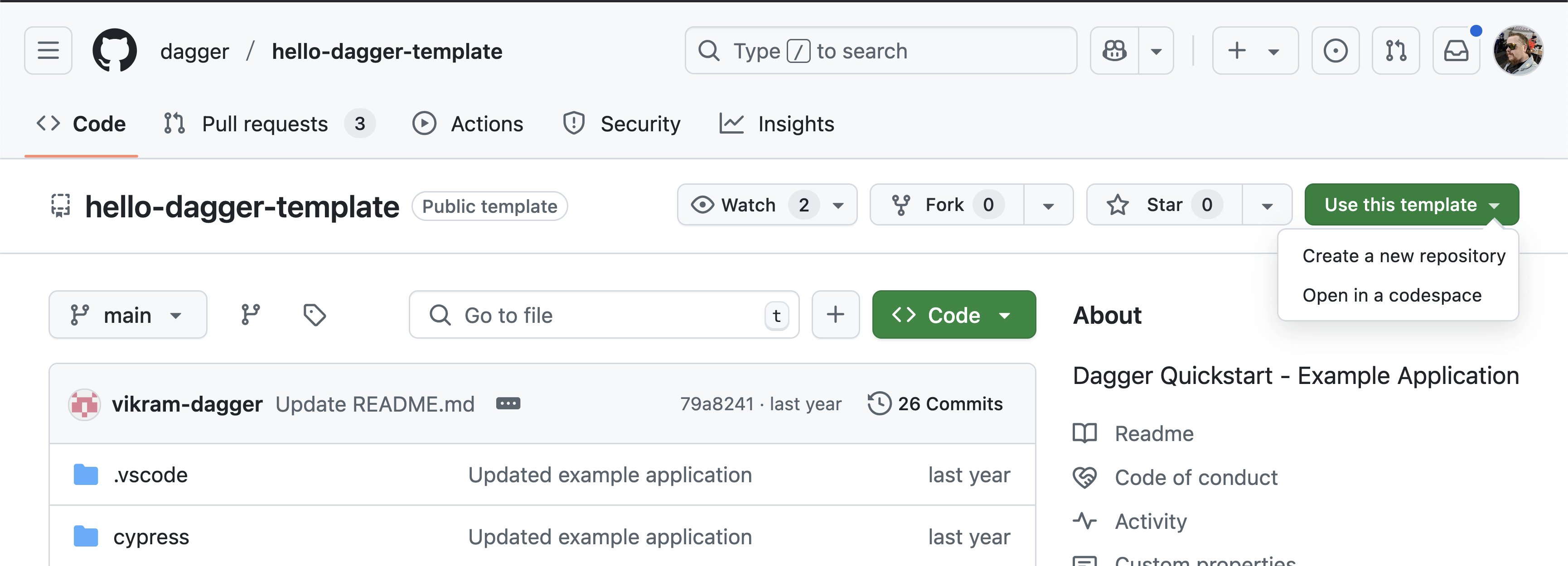Use a Blueprint Module
A Dagger module may reference another module as its blueprint.
Using a module as a blueprint means that your module will automatically have the functions of the blueprint module directly callable. This is great for platform teams daggerizing many software components with identical stacks because each project does not need to reimplement the same code in every project, they simply install the blueprint.
When you use a blueprint module, the context directory will automatically be your repository rather than the blueprint's repository.
This quickstart will guide you through using a blueprint module in an example application.
Requirements
This quickstart will take you approximately 5 minutes to complete.
Before beginning, ensure that:
- you have installed the Dagger CLI.
- you know the basics of Dagger.
- you have Git and a container runtime installed on your system and running. This can be Docker, Podman, nerdctl, Apple Container, or other Docker-like systems.
- you have a GitHub account (optional, only if configuring Dagger Cloud)
Get the example application
The example application is a skeleton Vue framework application that returns a "Hello from Dagger!" welcome page. Create a Github repository from the hello-dagger-template and set it as the current working directory:
In the GitHub UI:

Clone your new repository and set it as the current working directory.
Or with the gh CLI:
gh repo create hello-dagger --template dagger/hello-dagger-template --public --clone
cd hello-dagger
Configure Dagger Cloud (optional)
This step is optional and will create a Dagger Cloud account, which is free of charge for a single user. If you prefer not to sign up for Dagger Cloud, you can skip this section.
Dagger Cloud is an online visualization tool for Dagger workflows. It provides a web interface to visualize each step of your workflow, drill down to detailed logs, understand how long operations took to run, and whether operations were cached.
Create a new Dagger Cloud account by running dagger login:
dagger login
The Dagger CLI will invite you to authenticate your device by displaying a link containing a unique key. Click the link in your browser, and verify that you see the same key in the Dagger Cloud Web interface.
$ dagger login
Browser opened to: https://auth.dagger.cloud/activate?user_code=FCNP-SRLM
Confirmation code: FCNP-SRLM
Once you confirm your authentication code, your Dagger CLI will be authenticated and you will get redirected to your newly created Dagger Cloud organization.
After successfully creating your organization, all future Dagger workflows can be inspected in Dagger Cloud.
Initialize a Dagger module with a blueprint
Create a new Dagger module using dagger init, but using an existing module as a blueprint.
dagger init --blueprint=github.com/kpenfound/blueprints/hello-dagger
The --blueprint flag means the new module will use the Dagger module at github.com/kpenfound/blueprints/hello-dagger as a blueprint, meaning I can use that module directly with dagger call.
See what tools have been installed:
dagger functions
You will see:
dagger functions
▶ connect 0.2s
▶ load module: . 1.0s
Name Description
build Build the application container
build-env Build a ready-to-use development environment
publish Publish the application container after building and testing it on-the-fly
test Return the result of running unit tests
So the functions in the github.com/kpenfound/blueprints/hello-dagger module are now available to be used!
Try running the test function:
dagger call test
Next steps
Congratulations! You've installed your first blueprint module with Dagger.
Now you have the tools to successfully take the next step: adopting Dagger in your project.
In the meantime, we encourage you to join our awesome community on Discord to introduce yourself and ask questions. And starring our GitHub repository is always appreciated!